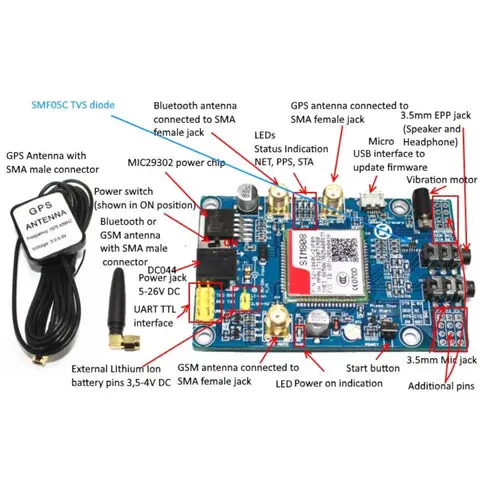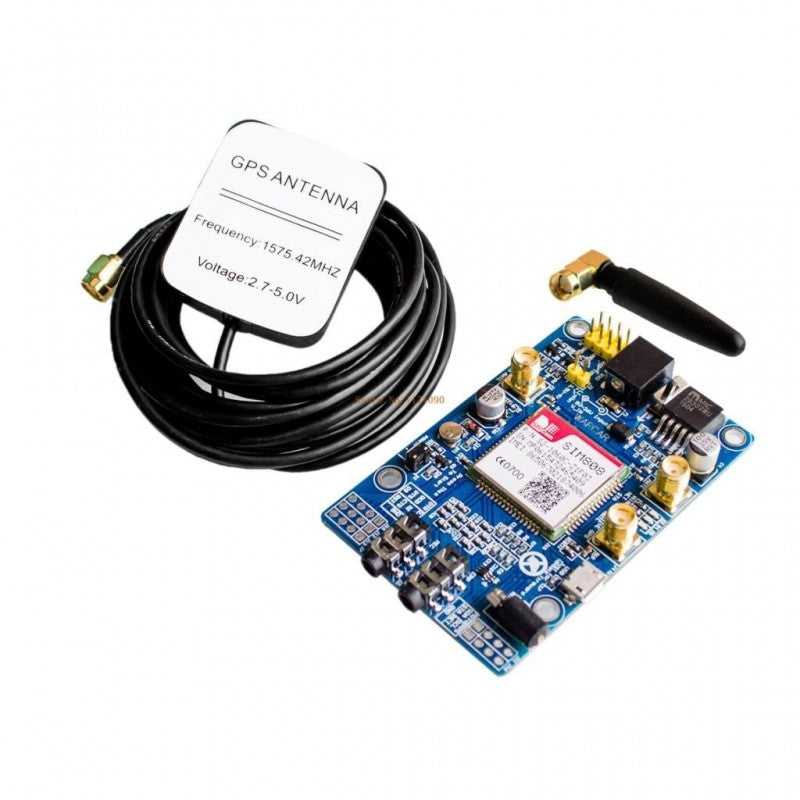SIM808 GSM GPRS GPS Development Board
This development board includes Bluetooth.

Description:
1.Three power input interface: DC044 interface and V_IN and a lithium battery interface.
Note that: The range of DC044 and the V_IN pin voltage input is 5 - 26V, when using the 5V as the power, be sure that the power supply can provide 2A current. The range of voltage of Lithium battery input power is 3.5 - 4.2V.
2. Switch: It is used to open / close the input power supply for the module. When in use, please confirm the toggle switched to the OPEN state (near the board inside).
3. SMA antenna interface: there is a GSM antenna interface, a GPS antenna interface onboard and a BT antenna interface.
4. Start button: When the board is power on, the LED (PWR) will light up. After a long press (about 2 seconds) on this button, the other three LEDs will be light. And one of them starts to flash; this suggests that SIM808 is beginning to work now. When the power supply, GSM and GPS antenna and SIM card are connected to the module correctly, the LED will be flash slowly (3Second de 1second light), that indicates that the module is registered to the network, and you can make a call or do something else.
5. TTL serial interface: a TTL level interface. Notice that: The pin of VMCU is used to control the high level of TTL UART, so as to realize to match between 1.25V/3.3V /5V systems. For example, if you want to use the 51 MCU to control this board, the pin of VMCU should be connected to the DC5V. And if using the STM32 MCU, the pin of VMCU should be connected the DC3.3V. The pins of RXD is the RXD of SIM808 and the pins of TXD is the TXD of SIM808. The pin of V_IN can connect the Power, the function of this pin has the same function of DC044.
6. USB interface: This interface is just used to update the firmware of SIM808 module.
Operations:-
1. Preparation: SIM808 SHIELD, DC9V adapter, USB-TTL module or other tools, PC software
2. Hardware configurations
2.1 Connect the USB-TTL to the UART interface
USB-TTL SIM808
TXD RXD
RXD TXD
GND GND
2.2 Insert the valid SIM card to the SIMCARD holder.
2.3 Connect the GPS antenna and GSM antenna to the board
2.4 Connect the power adapter to the DC044 Interface
2.5 Change the switch
2.6 Press the POWKEY button for 2 seconds, the SIM808 module will work and the other 3 LEDs will light.
Specifications:-
- 5-18V power supply supported.
- USB port can be very convenient.
- Serial USB TTL compatible for 2.85V, 3.3V and 5v signal
- GSM, GPRS, GPS {text messaging, data transmission, positioning} triple function.
- Quad-band communications, globally available. , AT command operation, can support SMS, phone, GPRS data, GPS data is automatically output, embedded TCP protocol to support transparent mode and command mode, supports HTTP protocol to support DTMF decoding, support MMS, support recording function, and so on.
- IPX antenna connector
- Reserved USB port (not solder) available for changing firmware. So you can update for Bluetooth.
- Quad-band 850/900/1800/1900MHz
- GPRS multi-slot class 10 standard
- GPRS mobile station class B standard
- Meet the GSM phase 2/2 + standards:-
- Class 4 (2 W @ 850/900 MHz)
- Class 1 (1 W @ 1800/1900MHz)
- AT command control (GSM 07.07, 07.05 and SIMCom enhanced AT command set)
- SIM Application Toolkit
- Supply voltage range:
- GPRS: 3.2 ~ 4.8 V
- GPS: 3.0 ~ 4.5V
- Low power consumption
- Size: 30 * 30 * 3.2mm
- Weight: SIM908: 5.2g
- Working temperature: -40 ° Cto +85 ° C
- SMS
- Point MO and MT
- SMS Cell Broadcast
- Text and PDU mode
- Voice, Three kinds of rate
- Half Rate (HR)
-
Full-rate (FR)
-
Enhanced Full Rate (EFR)
-
Handsfree function
-
Support echo suppression algorithm
-
GPRS data
-
GPRS class 8/10: Maximum 85.6 kbps (downlink rate)
-
Support PBCCH
-
Coding schemes CS 1, 2, 3, 4
-
PPP-stack
-
CSD data
-
CSD up to 14.4 kbps
-
USSD
-
Nontransparent
-
Compatibility:AT cellular command interface
-
GPS Receiver Type
-
Receive 42 channels
-
GPS L1 C / A code,
-
High-performance STE engine
-
-
Sensitivity
-
Tracking: -160 dBm
-
Cold starts: -143 dBm
-
-
Time-To-First-Fix
-
Cold start: 30s (typ.)
-
Hot start: 1s (typ.)
-
-
Accuracy
-
Accurate positioning: <2.5 m CEP
-
-
Power consumption (GSM idle mode)
-
Capture 77mA
-
Tracking 76mA
-
Useful Links:

